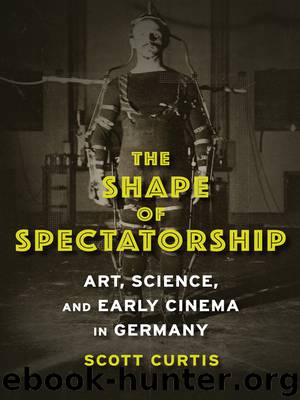The Shape of Spectatorship by Scott Curtis

Author:Scott Curtis
Language: eng
Format: epub
Tags: PER004030, Performing Arts/Film & Video/History & Criticism, HIS014000, History/Europe/Germany
Publisher: Columbia University Press
Published: 2015-10-19T16:00:00+00:00
There is no theatre without a spectator…. But according to the accusers, being a spectator is a bad thing for two reasons. First, viewing is the opposite of knowing: the spectator is held before an appearance in a state of ignorance about the process of production of this appearance and about the reality it conceals. Second, it is the opposite of acting: the spectator remains in her seat, passive. To be a spectator is to be separated from both the capacity to know and the power to act.16
The idea of aesthetic contemplation from Kant and Schiller to early twentieth-century professional aestheticians looks like a deliberate attempt to counter the problem of passivity in spectatorship by endowing the viewer with both a protocol and a philosophical justification that connect aesthetic enjoyment to reasoning and knowledge production (“the capacity to know”), on one hand, and political maturity or citizenship (“the power to act”) on the other. Endowing aesthetic contemplation with agency and linking it to individual or civic identity gave this mode of viewing the moral weight it needed to counter a mode of viewing perceived to be common to the passive, irresponsible crowd. The contemporary discussion of the cinematic experience could not avoid confronting this weighty connection between agency and contemplation—often to film’s disadvantage.
Precisely because contemplation had long been endowed with high moral import—with values such as reason and citizenship—any changes to the conditions of contemplation put these values at risk, especially as mass reception became more common with new urban demographics and forms. If cinema were not at the heart of these transformations, for many essayists it was a worst-case scenario. At the same time, however, the discussion about cinema was not merely a reactionary defense of Enlightenment-era ideals; it was a collective attempt to find some common ground, to ask (often implicitly) whether contemplation was the proper way to engage with these new forms, and if not, what was? In fact, Benjamin’s own position on the relative value of contemplation and distraction was not limited to his words in the “Work of Art” essay. As Carolin Duttlinger has shown, Benjamin’s conception of attention (Aufmerksamkeit) played a central and complex role from his earliest essays, and if he advocated distraction (Zerstreuung) as the perceptual stance most appropriate toward modernity in the “Work of Art” essay, that was only one part of a long conversation he had with himself about the relationship between a mode of viewing and one’s position toward and within modern life.17 Ultimately, this conversation was about the relationship between “a way of being with images,” in Dudley Andrew’s ingenious phrase,18 and a way of being in the world. For Benjamin as well as the writers of the Kino-Debatte decades earlier, the two stances were one and the same.
So this chapter will explore the status of aesthetic reception in the context of discussions about cinematic spectatorship. The first section will trace the broad themes in the Kino-Debatte about movies, modernity, and spectatorship in relation to the rhetorical or ideological categories of time and agency.
Download
This site does not store any files on its server. We only index and link to content provided by other sites. Please contact the content providers to delete copyright contents if any and email us, we'll remove relevant links or contents immediately.
The Kite Runner by Khaled Hosseini(5083)
Gerald's Game by Stephen King(4581)
Dialogue by Robert McKee(4321)
The Perils of Being Moderately Famous by Soha Ali Khan(4169)
The 101 Dalmatians by Dodie Smith(3452)
Story: Substance, Structure, Style and the Principles of Screenwriting by Robert McKee(3397)
The Pixar Touch by David A. Price(3362)
Confessions of a Video Vixen by Karrine Steffans(3243)
How Music Works by David Byrne(3186)
Fantastic Beasts: The Crimes of Grindelwald by J. K. Rowling(2994)
Harry Potter 4 - Harry Potter and The Goblet of Fire by J.K.Rowling(2990)
Slugfest by Reed Tucker(2938)
The Mental Game of Writing: How to Overcome Obstacles, Stay Creative and Productive, and Free Your Mind for Success by James Scott Bell(2844)
4 - Harry Potter and the Goblet of Fire by J.K. Rowling(2654)
Screenplay: The Foundations of Screenwriting by Syd Field(2574)
The Complete H. P. Lovecraft Reader by H.P. Lovecraft(2514)
Scandals of Classic Hollywood: Sex, Deviance, and Drama from the Golden Age of American Cinema by Anne Helen Petersen(2465)
Wildflower by Drew Barrymore(2443)
Robin by Dave Itzkoff(2383)
